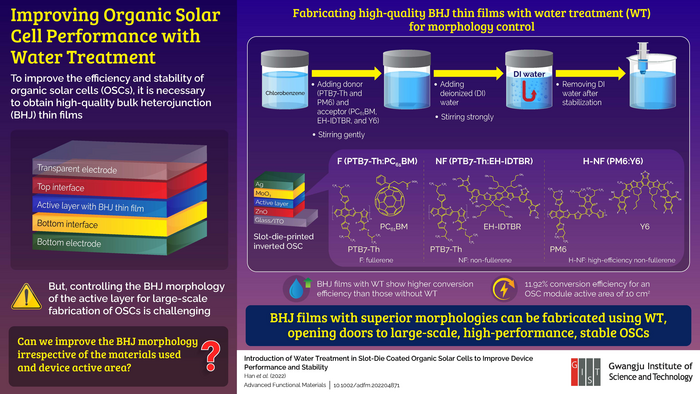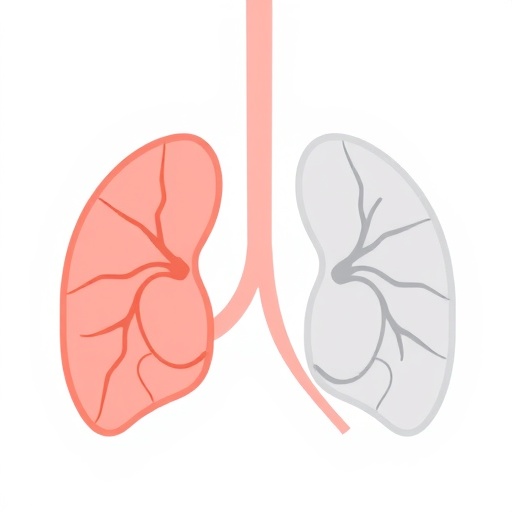Organic solar cells (OSCs), which use organic polymers to convert sunlight into electricity, have received considerable attention in recent times for their desirable properties as next-generation energy sources. These include lightweight, flexibility, scalability, and a high power conversion efficiency (>19%). Currently, several strategies exist for enhancing the performance and stability of OSCs. However, a problem that lingers on is the difficulty of controlling the morphology of the active layer in OSCs when scaling up to large areas. This makes it challenging to obtain high-quality active layer thin films and, in turn, fine-tune the device efficiency.

Credit: Dong-Yu Kim from Gwangju Institute of Science and Technology
Organic solar cells (OSCs), which use organic polymers to convert sunlight into electricity, have received considerable attention in recent times for their desirable properties as next-generation energy sources. These include lightweight, flexibility, scalability, and a high power conversion efficiency (>19%). Currently, several strategies exist for enhancing the performance and stability of OSCs. However, a problem that lingers on is the difficulty of controlling the morphology of the active layer in OSCs when scaling up to large areas. This makes it challenging to obtain high-quality active layer thin films and, in turn, fine-tune the device efficiency.
In a recent study, a team of researchers from the Gwangju Institute of Science and Technology, Korea set out to address this issue. In their work, published in Advanced Functional Materials, they suggested a solution that appears rather counterintuitive at first glance: using water treatment to control the active layer morphology. “Water is known to hinder the performance of organic electronic devices, since it remains in the ‘trap states’ of the organic material, blocking the charge flow and degrading the device performance. However, we figured that using water rather than an organic solvent-based active solution as a medium of treatment method would enable necessary physical changes without causing chemical reactions,” explains Professor Dong-Yu Kim, who headed the study.
The researchers chose the polymers PTB7-Th and PM6 as donor materials and PC61BM and EH-IDTBR and Y6 as acceptor materials for the active layer. They noticed that inducing a vortex to mix the donor and acceptor materials in the active solution could lead to a well-mixed active solution, yet it was not enough on its own. The active solution was hydrophobic and, accordingly, the researchers decided to use deionized (DI) water and vortices to stir the solution. They let the donor and acceptor materials sit in chlorobenzene (host active solution) overnight, and then added DI water in the solution and stirred it, creating tiny vortices. Due to the hydrophobic nature of the solution, the water pushed on the donor and acceptor molecules, causing them to dissolve more finely into the solution. They then let the solution rest, which caused the water to separate from the solution. This water was then removed and the water-treated active solution was used to prepare thin films of PTB7-Th: PC61BM (F, fullerene), PTB7-Th: EH-IDTBR (NF, fullerene), and PM6: Y6 (H-NF, high-efficiency non-fullerene).
The researchers then examined the photovoltaic performance of these thin films in a slot-die-coated inverted OSC configuration and compared them with those for OSCs without water treatment.
“We observed that the water-treated active solution led to a more uniform active layer thin films, which showed higher power conversion efficiencies compared to those not treated with water. Moreover, we fabricated large-area OSC modules with an active area of 10 cm2, which showed a conversion efficiency as high as 11.92% for water-treated H-NF films,” highlights Prof Kim.
Overall, this study provides a guideline for developing large-scale, efficient OSCs using a remarkably easy, economical, and eco-friendly method, which can open doors to their realization and commercialization.
***
Reference
DOI: https://doi.org/10.1002/adfm.202204871
Authors: Nara Han1, Youn-Jung Heo1, Minwoo Lee1, Yina Moon1, Dongseong Yang1, Yunseul Kim1, and Dong-Yu Kim1
Affiliations:
1School of Materials Science and Engineering, Gwangju Institute of Science and Technology
About the Gwangju Institute of Science and Technology (GIST)
The Gwangju Institute of Science and Technology (GIST) is a research-oriented university situated in Gwangju, South Korea. Founded in 1993, GIST has become one of the most prestigious schools in South Korea. The university aims to create a strong research environment to spur advancements in science and technology and to promote collaboration between international and domestic research programs. With its motto of “A Proud Creator of Future Science and Technology,” GIST has consistently received one of the highest university rankings in Korea.
Website: http://www.gist.ac.kr/
About the author
Dong-Yu Kim is a distinguished Professor of Materials Science and Engineering and Head Director of Solar Cell Research Center of Research Institute for Solar and Sustainable Energies at Gwangju Institute of Science and Technology (GIST), Korea. He completed his Ph.D. in Polymer Science/Plastics Engineering at University of Massachusetts Lowell, USA. At GIST, his group is developing new approaches in organic electronics through material synthesis and device optimization for high device performance, and carbon-based nanomaterials for improving charge transporting properties. In 2016, Prof. Kim was awarded the National Science and Technology Medal in South Korea.
Journal
Advanced Functional Materials
DOI
10.1002/adfm.202204871
Method of Research
Experimental study
Subject of Research
Not applicable
Article Title
Introduction of Water Treatment in Slot-Die Coated Organic Solar Cells to Improve Device Performance and Stability
Article Publication Date
23-Jun-2022
COI Statement
The authors declare no conflict of interest.




